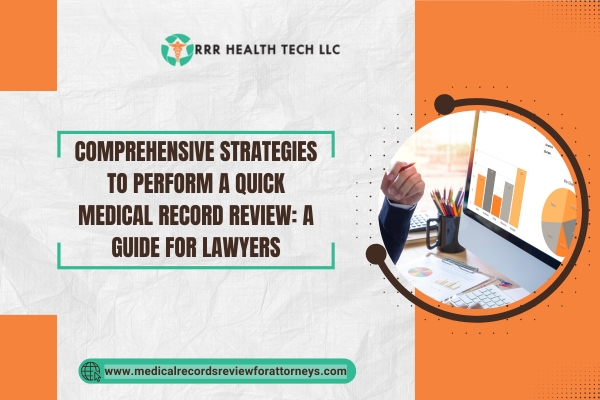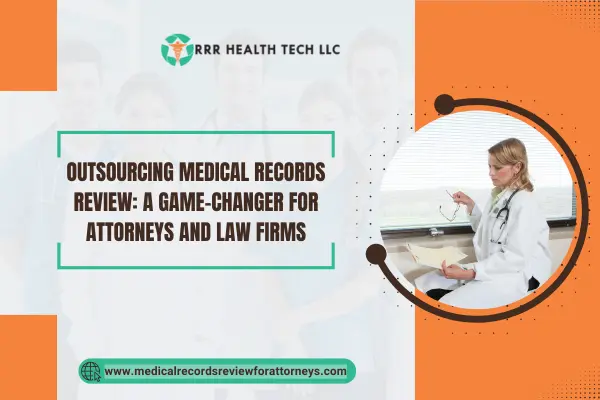
Introduction
In legal practice, detailed medical record reviews are often necessary to build any effective personal injury and medical malpractice cases. This article will discuss and provide handy techniques for the medical record review process, especially how these techniques can be beneficial for attorneys in America. Following these techniques, the legal practitioners’ readiness in case preparation will improve, and the results for the clients will be more favorable.
Recognizing the Value of Medical Records
What is the Medical Record Review Process?
• Definition: A medical record review is the process where a patient’s medical history, treatments, and other relevant files are studied for their relevance in the development of a legal claim.
• Purpose: The objective focus on determining the case’s adverse events in question, such as the injury suffered, treatment to the injury, and if there was some neglect involved.
Why Medical Record Review Is Important For a Lawyer?
• Demonstrative Evidence: Medical documents are of extreme importance as they form the basis in the case of personal injury and cases of malpractice.
• Credibility of a Case: A medical record review strengthens the case credibility due to available proof of injuries and treatments.
• Crucial Issues: A lawyer can find omissions, contradictions, or essential details that influence the case.
Important Practices to Review Medical Records in a Timely Manner
1. Construct a Schedule for the Review
• Outline A Checklist: Design a thorough checklist with every document and piece of information that requires reviewing.
• Streamline Methods: Set record review methods to guarantee uniformity and thoroughness.
2. Apply Software and Technology
• Electronic Health Records (EHR): Use EHR systems to improve the accessibility of medical records and aid in data retrieval.
• Review Software: Use automated software applications that are specifically designed for medical record review.
3. Target Essential Content
• Determine Relevant Portions: Identify pertinent areas of the medical records, including, but not limited to:
• Admission notes
• Treatment Plans
• Discharge Summaries
• Important Marked Findings: Important details that are relevant to the case should be marked for easy retrieval.
4. Consult Medical Professionals
• Consult: Work with medical professionals to clarify the meaning of medical terms and treatment procedures in the case file.
• Get Standard of care Expert Opinion: Expert opinion should be given regarding standard of care and any omissions that do not meet the caregiver expected standard of care which borders on negligence.
5. Ensure Findings are Well Documented
• Take Notes on Findings: Make comprehensive notes of all details, relevant anomalies, and other significant findings during the review process.
• Organize Records: Make certain that all records that have been reviewed are well organized and easily retrievable.
“6. Implement Quality Control Measures”
• Peer Reviews: Review the analysis of the medical records for accuracy and completeness by another qualified person.
• Feedback Mechanism: Build a means of providing comments and suggestions for improving the review process as it is being completed.
“7. Stay Up to Date with Legal and Medical Regulations”
• Continuing Education: Take part in associated training sessions dealing with changes in the legal and medical practice standards.
• Circulars: Make it a duty for the best authority to review and report best practices from time to time and regularly.
“8. Use Visual Aids”
• Charts and Graphs: Use visual aids to convey intricate medical statistics in an elucidated and condensed format.
• Event timelines: Build event timelines to demonstrate the order of medical procedures and other related occurrences.
“9. Prioritize Confidentiality and Compliance Issues”
• HIPAA Violations: Ensure that each review of records of patients’ files is done in the highest standard of confidentiality.
• Transaction Restriction: Employ restrictions on the transactions dealing with medical files and records.
“10. Explain to Subordinates the Most Proper Techniques in Avoiding Errors”
• On the Job Training: Organize a course for the personnel in any department dealing with reviewing medical records to explain the methods and legal aspects.
• Instruction Guides: Prepare instruction manuals to assist staff during the review process.
Current Data and Statistics (Year 2024)
• Increased Demand: The demand for medical record review services rose by 20% in 2024 because of a quarter increases in personal injury claims and medical malpractice lawsuits.
• Efficiency Gains: Technology implementation in record review greatly increases efficiency; with some stating review time is reduced by as much as 30%, allowing attorneys more time to focus on case strategy.
Case Studies
Case Study 1: Personal Injury Case
• Overview: A client was injured in a car accident and needed to receive compensation for out of pocket medical expenses incurred as a result of the accident.
• Challenges: The medical records were not available and therefore the extent of injuries could not be established.
• Solutions: A complete review of all available medical records was done, along with a multiple provider cross check with the treatment providers to fill in the gaps and obtain missing documentation.
Case Study 2: Medical Malpractice Case
• Overview: A patient claimed malpractice following treatment for a chronic condition claiming that it was not properly attended to.
• Challenges: The medical records had several discrepancies in regard to the treatment as well as offer diagnosis that was provided.
• Solutions: A medical record expert was consulted with the records to explain the standard of care rendered and the contradictions observed during the processes were recorded.
Conclusion
In the realm of personal injury and medical malpractice legal practice, effective medical record review is fundamental and pivotal. The use of organized methods, technology, and collaboration with physicians enables lawyers to improve case preparation considerably. The combination of these factors not only increases the quality of evidence, but also the chances of achieving a favourable outcome for the clients.


